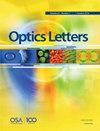基于光纤的极限学习机的非线性和色散光纤传播极限。
IF 3.1
2区 物理与天体物理
Q2 OPTICS
引用次数: 0
摘要
本文报道了一种基于光纤传播的极限学习机(ELM)的广义非线性Schrödinger方程仿真模型。使用MNIST手写数字数据集作为基准,我们研究了准确性如何依赖于传播动态,以及控制频谱编码、读出和噪声的参数。对于该数据集,在量子噪声有限输入的情况下,在异常和正常色散状态下的传播测试精度分别超过91%和93%。我们的研究结果还表明,输入脉冲上的量子噪声会对ELM的性能产生内在的影响。本文章由计算机程序翻译,如有差异,请以英文原文为准。
Limits of nonlinear and dispersive fiber propagation for an optical fiber-based extreme learning machine.
We report a generalized nonlinear Schrödinger equation simulation model of an extreme learning machine (ELM) based on optical fiber propagation. Using the MNIST handwritten digit dataset as a benchmark, we study how accuracy depends on propagation dynamics, as well as parameters governing spectral encoding, readout, and noise. For this dataset and with quantum noise limited input, test accuracies of over 91% and 93% are found for propagation in the anomalous and normal dispersion regimes, respectively. Our results also suggest that quantum noise on the input pulses introduces an intrinsic penalty to ELM performance.
求助全文
通过发布文献求助,成功后即可免费获取论文全文。
去求助
来源期刊

Optics letters
物理-光学
CiteScore
6.60
自引率
8.30%
发文量
2275
审稿时长
1.7 months
期刊介绍:
The Optical Society (OSA) publishes high-quality, peer-reviewed articles in its portfolio of journals, which serve the full breadth of the optics and photonics community.
Optics Letters offers rapid dissemination of new results in all areas of optics with short, original, peer-reviewed communications. Optics Letters covers the latest research in optical science, including optical measurements, optical components and devices, atmospheric optics, biomedical optics, Fourier optics, integrated optics, optical processing, optoelectronics, lasers, nonlinear optics, optical storage and holography, optical coherence, polarization, quantum electronics, ultrafast optical phenomena, photonic crystals, and fiber optics. Criteria used in determining acceptability of contributions include newsworthiness to a substantial part of the optics community and the effect of rapid publication on the research of others. This journal, published twice each month, is where readers look for the latest discoveries in optics.
 求助内容:
求助内容: 应助结果提醒方式:
应助结果提醒方式:


